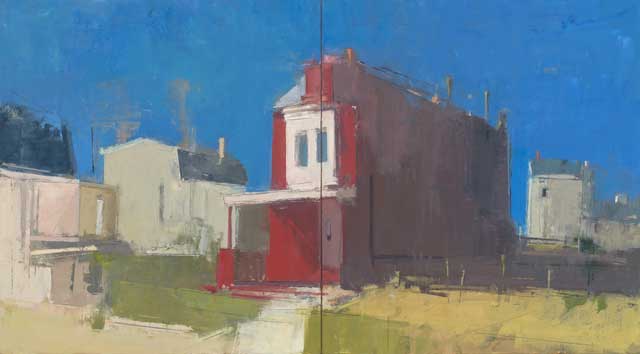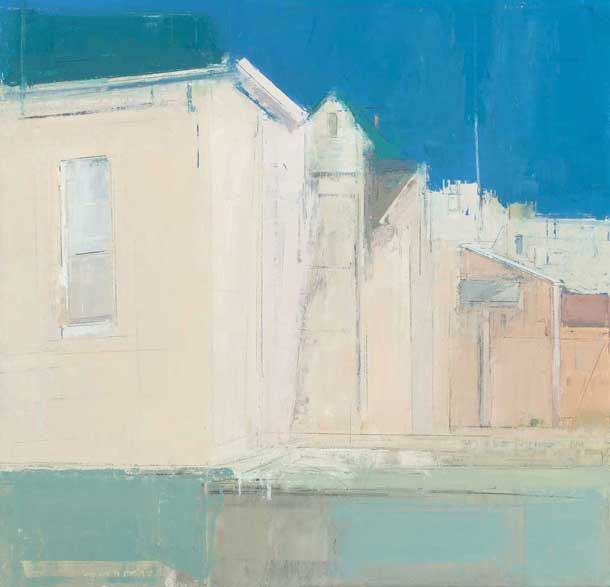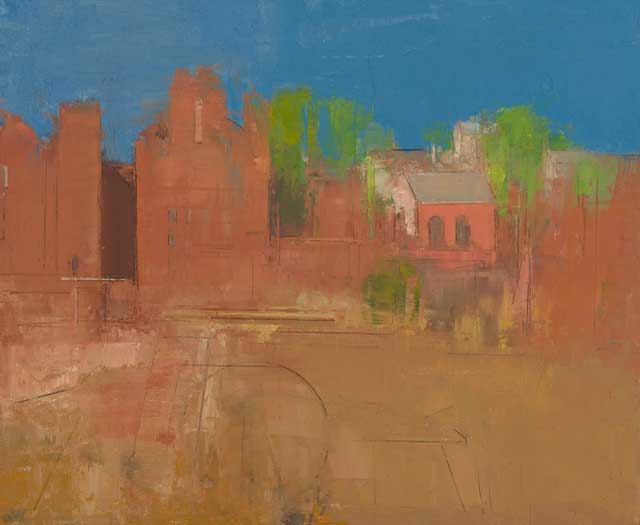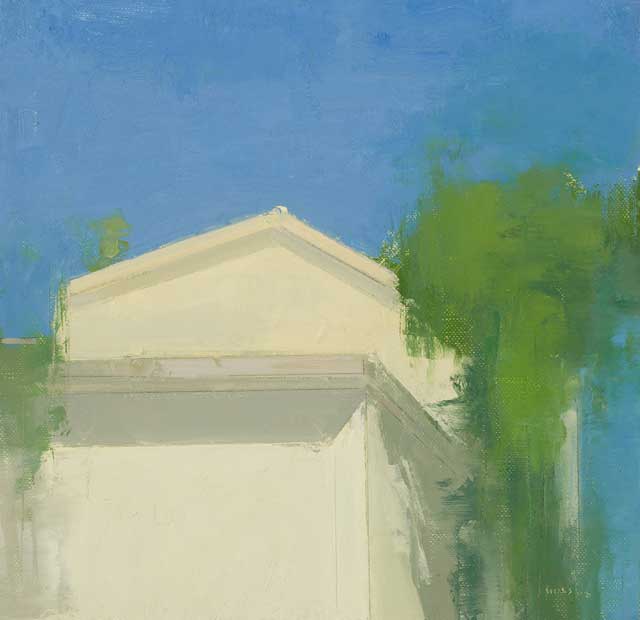“If the painter is open to the world, everything becomes grist for the mill, even things one doesn’t expect or even doesn’t consciously like or want. It’s not a matter of what is “important” in the terms of the “real” world – money, new car, Armani suit. Maybe painters, poets and dreamers fill their head with very ordinary things that hit us like big waves – fleeting light on the sidewalk is a big deal as can how a tree in late October looks though a steamed up window after getting out of the shower on a cold morning. We really want the ordinary and unexpected to visually stop us dead in our tracks.”
Painting Perceptions is very fortunate to have Stuart Shils agree to this interview and to share with us his influences, process and his many profound insights into perceptual painting.
(Please note: for anyone possibly interested in a workshop with Stuart Shils in San Diego, hopefully sometime in the late spring or early summer 2011 please email me for leave a comment with this post. You may also find out information on workshops with him through Stuart Shils’ website)
This interview was conducted via email with Larry Groff (LG) and Stuart Shils (SS)
LG You studied at Pennsylvania Academy of the Fine Arts in the late 70’s setting and your work has evolved from a traditional style to a more Modernist sensibility. Who and/or what were some of the greatest influences in shaping your growth as a painter?.
SS Influences? Oh, where to even begin except in the fields of early memory. Cinematic glimpses and cropped sequences of very ordinary moments from childhood are like a string of mystical pearls worn close to the chest, whose feeling and luminosity precede who actually were formal “teachers”; and all this long before going to museums, galleries or even thinking about making “art”. What really matters? – the surface and color of scrambled eggs that came with a breakfast one morning while with my parents in Atlantic City when I was quite young; the passion with which my grandfather ate fresh sliced oranges, the juice dripping down his chin; the light coming through someone’s hair in French class in 8th grade; discovering the texture and structure of an opening, crashing chord on the B side of a Kinks hit when I was 13.

(click for larger view – true all images in this article)
As painters we all have the equivalent of parental figures whose shadows are long and persuasive and often very problematic, and then after one leaves home (which is never quite a clean cut done deal anyway) a multitude of other influences accumulate like an evolving stamp collection. And there are chemical actions and reactions within the mix, which is really the way it has to be if you are going to be open and also passionate. What might be unassailable truth and absolute certainty one day, five years later may not even be part of the conversation. If the painter is open to the world, everything becomes grist for the mill, even things one doesn’t expect or even doesn’t consciously like or want. It’s not a matter of what is “important” in the terms of the “real” world – money, new car, Armani suit. Maybe painters, poets and dreamers fill their head with very ordinary things that hit us like big waves – fleeting light on the sidewalk is a big deal as can how a tree in late October looks though a steamed up window after getting out of the shower on a cold morning. We really want the ordinary and unexpected to visually stop us dead in our tracks.
In terms of actual teachers, my initial and very powerful influences were (in this order): Doris Staffel, Francis Tucker, Arthur De Costa and Seymour Remenick, most of whom almost no one beyond Philadelphia or New York will have heard of, they were not hipsters or New York luminaries and some even without extensive exhibition credentials. But that sort of thing is irrelevant and on me, each in their way, left a distinctive impression. And it was often not as one would expect. For instance, Arthur De Costa was a very traditionally oriented painter and I remember as my work began to change in the years following PAFA where I was a conservatively minded student, I spoke with someone who had been a member of another camp at school and hostilely disliked my teacher on ideological grounds (we were all very factionalized politically), and he said sarcastically, well I saw your new painting and I wonder what your De Costa thinks of what has become of you! Meaning, now that I had departed from the obvious or more superficial sprit of De Costa’s work, he would have disapproved. But in fact, to the contrary, over that first decade out of school, De Costa was extremely encouraging, not at all trying to keep me tethered to his manner or point of view. What kind of parent wants the children to be just like him or her?
I suppose in terms of close painter friends whose spirits or works were influential, (while there was Sam Clayton when I was a student), perhaps in the early years out of school the most profound influence was Bill Scott, the first abstract painter (in this case I mean specifically someone who didn’t make paintings of “things”) I got to know well and whose sensibility and use of form helped reveal a still hidden world to my eyes. Remember that as a student I really thought abstraction (non objective painting) was a bunch of nonsense and the work of disingenuous intentions. Within my circle there was a kind of historical/fundamentalist zeal, we thought (so to speak) that God was on our side, and for the most part we didn’t look at anything after Courbet. Ok, Sargent was a big deal to us, and maybe occasionally Edward Hopper but he seemed (then) lightweight compared to Dosso Dossi or Carolus Duran!
In the early 90’s not long after we had met, I was walking with Bill through the Princeton Museum and he pointed to a Guston from the abstract gestural period, a beautiful golden/ochre-ish painting, the sort of thing I never looked at (then), but for whatever reasons my eyes were receptive and it struck me as a lyrical and eloquent canvas, obviously not “about” something, but very much about itself (as all good painting must be). Getting to know Bill’s work and his point of view really turned my head around with regard to re evaluating how to look at paintings and beginning to realize that words like abstract and realistic were being used as ideological clubs by perhaps frustrated people and really didn’t really define the crux and, were not such useful dichotomies. And as Whistler said, there are only two kinds of paintings, good ones and bad ones.
In more recent years, the work of Ken Kewley has been a revelation. And not in the most obvious ways with regard to color and composition, although that of course; but the exuberance and optimism that saturates the work strikes me as a much needed reminder of many things. Over the years, dealing with the market place, galleries, considering the words of critics and analysts, listening to what this one or that one likes or wants, it’s possible to forget what the original mission was, why we enter this path in the first place. To me, Ken’s work floats in a rare ether of sustained delight far, far from that “real” world madness (that we would all do better to forget about), and his visual cultivation and poetry strike at the heart of joy and deep feeling. Big things come in small packages, one just has to take time to slow down and tune in.
But in addition to all this, there was something else looming large. For the first many, many years out of school I worked primarily outside (absorbing and translating form as a quality of abstraction), and exposure to the light of day had enormous impact, something that I’ll try to describe. The accumulation of sensory experience, the layering of all those hits from going out every day and just looking and dreaming into visual time and into the palpability of painted space, just letting the eyes and mind wrap themselves around form in air and light space, and letting all of that get wrapped around the eyes, contributed to an encyclopedic repository of visual resonances, (packed tightly like the veneers of baltic birch plywood), that were beginning to add up to something beyond just painting objects or scenes. When out on the street painting buildings, or in the landscape painting fields, wrestling with converting it all into two-dimensional form took over as a process of abstraction first, and pulled my mind away from what the things/objects were. And over those years, the main priority became, almost without even thinking about it, how to organize forms within the two dimensional working space; in other words, first and foremost, how to compose, not “how to” paint a house. It was like going all the time to the gym, constantly working, and then one day you realize you have so much more endurance or stamina, and that the deltoids now really have a different articulation. But this is for the eyes not for the pectorals or deltoids. The process of sustained work is transformative, and the things that go through our minds are like a daily litany – where are the lights, where are the darks, what colors are they, what shape are they and, where and what are their edges like? And, how does it all fit together and maybe most importantly, what does it feel like and how do you feel about it?
But for me this process is not over, and I tell my young students here that the only difference between us is that I have made more paintings but please don’t think that I really have any idea what I’m doing. Just like them, I’m also on the side of the mountain, hooked up to ropes, hoping the landslide doesn’t come or if it does, to ride it out. Over the last 20 years, the force and challenges of the landscape itself, being in it and having to deal with its complexity – (and i don’t mean landscape as a calendar cliché, I’m thinking more as a formal abstraction and along the lines of massive sensory impact) – has been the greatest influence, my most significant teacher. It was gradual, and some things came first, without which I would not have been a position to fully engage or understand. 13 summers on the Irish coast really blew my fuse box off the wall (in the best sense) and the timing was perfect. Even though I had been outside for 12 years already, It seemed at first like a ridiculously difficult undertaking, and on arriving there i soon realized that I had a choice – either I was going to stay and put myself in front of it and risk being changed, blown over, or broken in two – or more likely, as it slowly appeared, initiated into some quality of relationship whose time had come. It’s weight, pulse, elegance and mystery, both informed and reassembled my expectations about everything.








Very inspiring and wise !
Outstanding! Thanks so much for this interview. He’s one of my favorites and I would love to take his class. He talks about a lot of the things I’m struggling with right now. Maybe Santa will reward me for being good all year.
Some great intense thoughts on painting and seeing. I really like the ideas he was talking about regarding the difference between ‘landscape’ and ‘scenery’, and how painters need to edit out the observed, see-able world, and focus on the construction of what’s happening on the picture plane. His work speaks of a deep involvement with the world, and it shows. Thanks
Great interview Stuart and Larry. Many thanks and will pass this on to the students etc… Best, IH
Thank-you very much Stuart and Larry… nice interview.
It is thrilling to read this discussion which has much to consider and digest.
Yeah, this was a really good interview. Painting as connected to a Kinks chord or whatever it is that grabs us in the world of our senses is really the game and Stuart has a great way of conveying the excitement of it with words and, of course, with his art.
thanks to both you.
dm
Awesome interview, Larry! I ended up doing his workshop in Philly and had a great experience. He is an incredible artist and instructor, as well as a great person. A lot of what was touched on in the interview was discussed in the class as well. Nice to have this wonderful resource to read over and really digest. My seed is taking root!
Hi Larry,
This is one of those interviews that I want to read every day. So many truths and poetic ways of describing the way we think and see as artists. LOVED IT!!
Thanks tons, love your blog!
Happy Holidays to YOU
Terrific interview! Questions and answers all so thoughtful, original, articulate, and helpful. I’d like to take a class in California in spring or early summer.
Absolutely outstanding!
This should be required reading for every art student and I would go s far as saying that every working artist would benefit from reading this often. So full of experience and intelligence! The paintings and drawings are truly beautiful as well.
Thanks for taking the time with this Larry and Stuart.
Thanks very much for doing this interview. Shils has always been one of my favorite painters, and this was wonderful to read and see. I particularly appreciate seeing his sketches, which are amazing.
Great interview on an inspiring artist! Much appreciated.
I got a chance to have Bill Scott in my studio during grad school and was really inspired by his perspective on observational painting. It makes it even more exciting knowing that a painter that I respect as much as Stuart holds Bill in such high regards as well. Great interview! Thanks, Dustin O’Hara
Love your stuff man. Very unique love the abstract qualities and the brightness of the colors. Really rate-type look. Ultra cool.
Great interview on an inspiring artist. Great collections of paintings there.